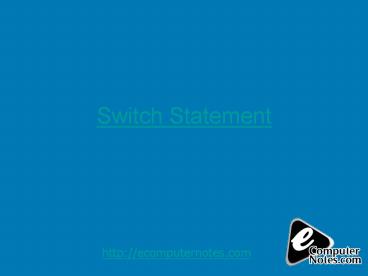Computer Notes - Switch Statement - PowerPoint PPT Presentation
Title:
Computer Notes - Switch Statement
Description:
- Computer Notes - Switch Statement in Object oriented Programming what is Switch Statement Explain about it in detail .explain it with example – PowerPoint PPT presentation
Number of Views:322
Title: Computer Notes - Switch Statement
1
Switch Statement
http//ecomputernotes.com
2
Problem Statement
- Develop a function that can draw different types
of geometric shapes from an array
http//ecomputernotes.com
3
Shape Hierarchy
Shape
draw calcArea
Line
Circle
Triangle
draw calcArea
draw calcArea
draw calcArea
http//ecomputernotes.com
4
Shape Hierarchy
- class Shape
- protected
- char _type
- public
- Shape()
- void draw() cout ltlt Shape\n
- int calcArea() return 0
- char getType() return _type
http//ecomputernotes.com
5
Shape Hierarchy
- class Line public Shape
- public
- Line(Point p1, Point p2)
- void draw() cout ltlt Line\n
http//ecomputernotes.com
6
Shape Hierarchy
- class Circle public Shape
- public
- Circle(Point center, double radius)
- void draw() cout ltlt Circle\n
- int calcArea()
http//ecomputernotes.com
7
Shape Hierarchy
- class Triangle public Shape
- public
- Triangle(Line l1, Line l2,
- double angle)
- void draw() cout ltlt Triangle\n
- int calcArea()
http//ecomputernotes.com
8
Drawing a Scene
- int main()
- Shape _shape 10
- Point p1(0, 0), p2(10, 10)
- shape1 new Line(p1, p2)
- shape2 new Circle(p1, 15)
- void drawShapes( shape, 10 )
- return 0
http//ecomputernotes.com
9
Function drawShapes()
- void drawShapes(Shape _shape,
- int size)
- for (int i 0 i lt size i)
- _shapei-gtdraw()
http//ecomputernotes.com
10
Sample Output
- Shape
- Shape
- Shape
- Shape
http//ecomputernotes.com
11
Function drawShapes()
- void drawShapes(
- Shape _shape, int size)
- for (int i 0 i lt size i)
- // Determine object type with
- // switch accordingly call
- // draw() method
http//ecomputernotes.com
12
Required Switch Logic
- switch ( _shapei-gtgetType() )
- case L
- static_castltLinegt(_shapei)-gtdraw()
- break
- case C static_castltCirclegt(_shapei)
- -gtdraw()
- break
13
Equivalent If Logic
- if ( _shapei-gtgetType() L )
- static_castltLinegt(_shapei)-gtdraw()
- else if ( _shapei-gtgetType() C )
static_castltCirclegt(_shapei)-gtdraw()
http//ecomputernotes.com
14
Sample Output
- Line
- Circle
- Triangle
- Circle
http//ecomputernotes.com
15
Problems with Switch Statement
http//ecomputernotes.com
16
Delocalized Code
- Consider a function that prints area of each
shape from an input array
http//ecomputernotes.com
17
Function printArea
- void printArea(
- Shape _shape, int size)
- for (int i 0 i lt size i)
- // Print shape name.
- // Determine object type with
- // switch accordingly call
- // calcArea() method.
http//ecomputernotes.com
18
Required Switch Logic
- switch ( _shapei-gtgetType() )
- case L
- static_castltLinegt(_shapei)
- -gtcalcArea() break
- case C static_castltCirclegt(_shapei)
- -gtcalcArea() break
http//ecomputernotes.com
19
Delocalized Code
- The above switch logic is same as was in function
drawArray() - Further we may need to draw shapes or calculate
area at more than one places in code
http//ecomputernotes.com
20
Other Problems
- Programmer may forget a check
- May forget to test all the possible cases
- Hard to maintain
http//ecomputernotes.com
21
Solution?
- To avoid switch, we need a mechanism that can
select the message target automatically!
http//ecomputernotes.com
22
Polymorphism Revisited
- In OO model, polymorphism means that different
objects can behave in different ways for the same
message (stimulus) - Consequently, sender of a message does not need
to know the exact class of receiver
http//ecomputernotes.com
23
Virtual Functions
- Target of a virtual function call is determined
at run-time - In C, we declare a function virtual by
preceding the function header with keyword
virtual - class Shape
- virtual void draw()
http//ecomputernotes.com
24
Shape Hierarchy
Shape
draw calcArea
Line
Circle
Triangle
draw calcArea
draw calcArea
draw calcArea
http//ecomputernotes.com
25
Shape Hierarchy Revisited
No type field
- class Shape
- virtual void draw()
- virtual int calcArea()
- class Line public Shape
- virtual void draw()
http//ecomputernotes.com
26
Shape Hierarchy Revisited
- class Circle public Shape
- virtual void draw()
- virtual int calcArea()
- class Triangle public Shape
- virtual void draw()
- virtual int calcArea()
http//ecomputernotes.com
27
Function drawShapes()
- void drawShapes(Shape _shape, int size)
- for (int i 0 i lt size i)
- _shapei-gtdraw()
http//ecomputernotes.com
28
Sample Output
- Line
- Circle
- Triangle
- Circle
http//ecomputernotes.com
29
Function printArea
- void printArea(Shape _shape, int size)
- for (int i 0 i lt size i)
- // Print shape name
- coutltlt _shapei
- -gtcalcArea()
- cout ltlt endl
http//ecomputernotes.com
30
Static vs Dynamic Binding
- Static binding means that target function for a
call is selected at compile time - Dynamic binding means that target function for a
call is selected at run time
http//ecomputernotes.com
31
Static vs Dynamic Binding
- Line _line
- _line.draw() // Always Linedraw // called
- Shape _shape new Line()
- _shape-gtdraw() // Shapedraw called
- // if draw() is not virtual
- Shape _shape new Line()
- _shape-gtdraw() // Linedraw called // if
draw() is virtual
http//ecomputernotes.com































